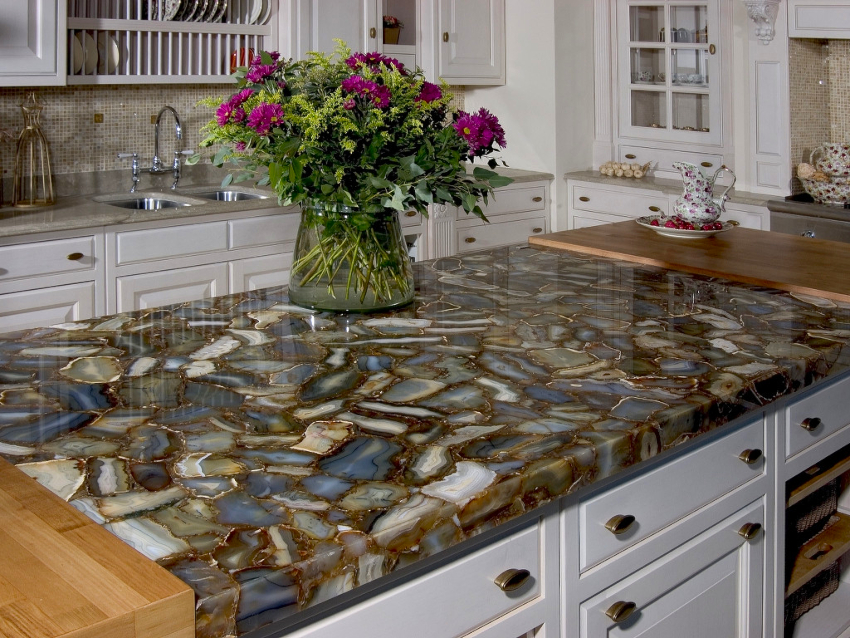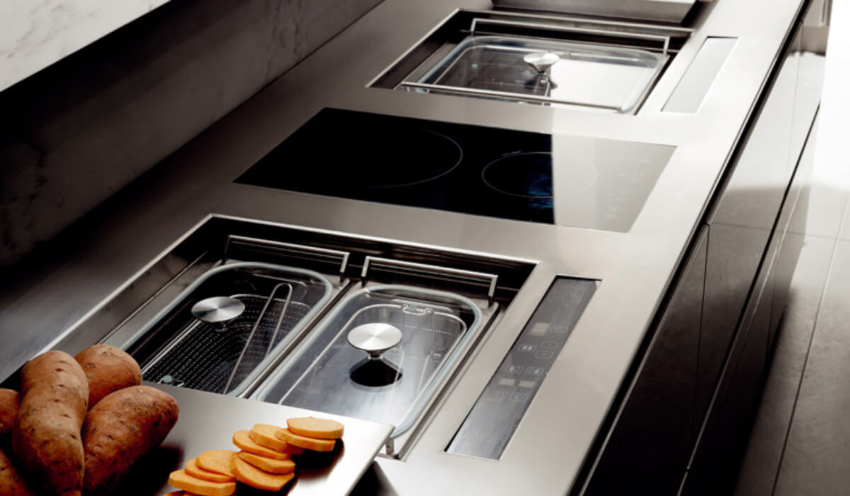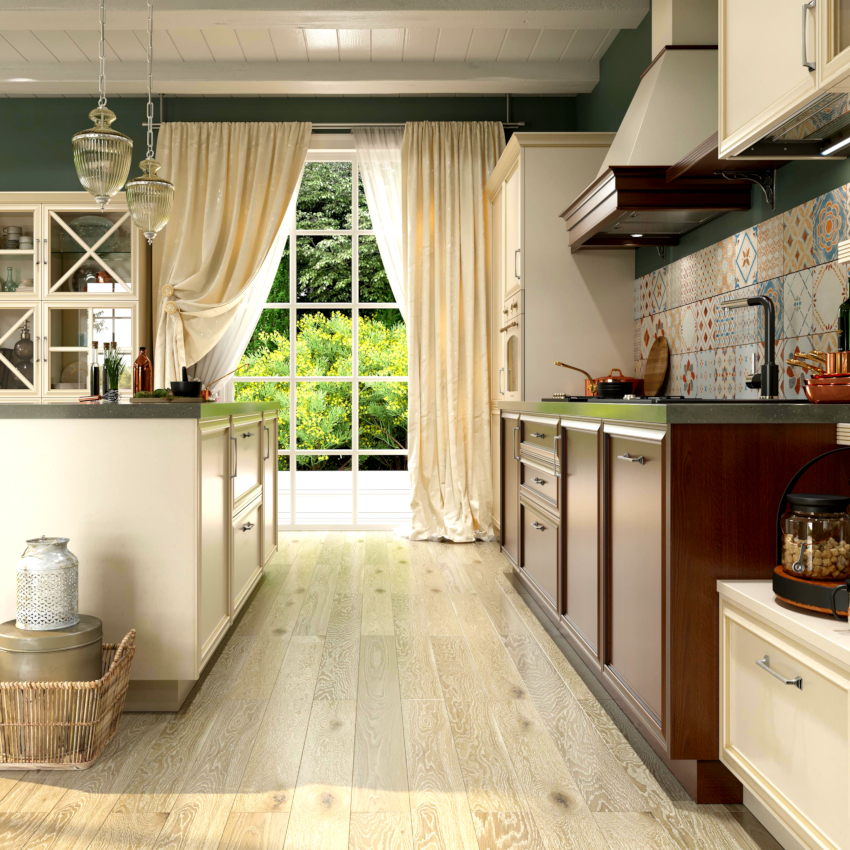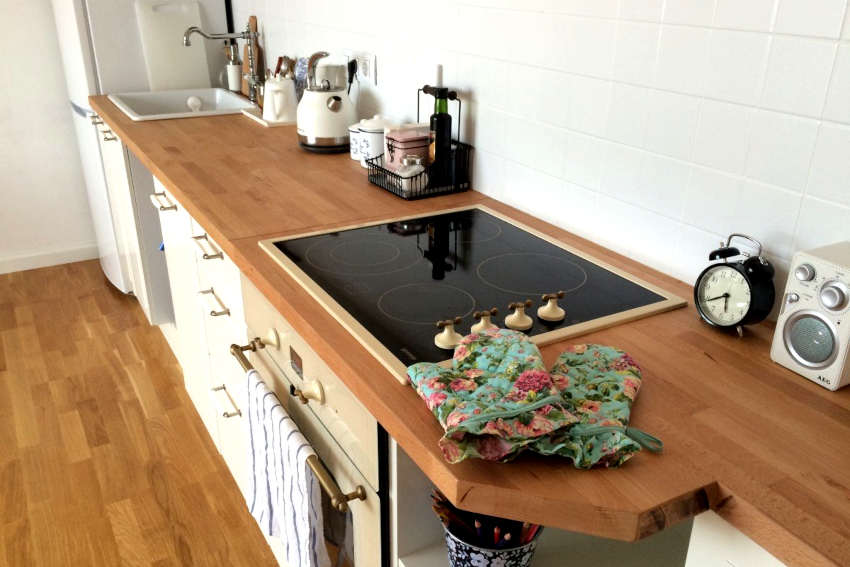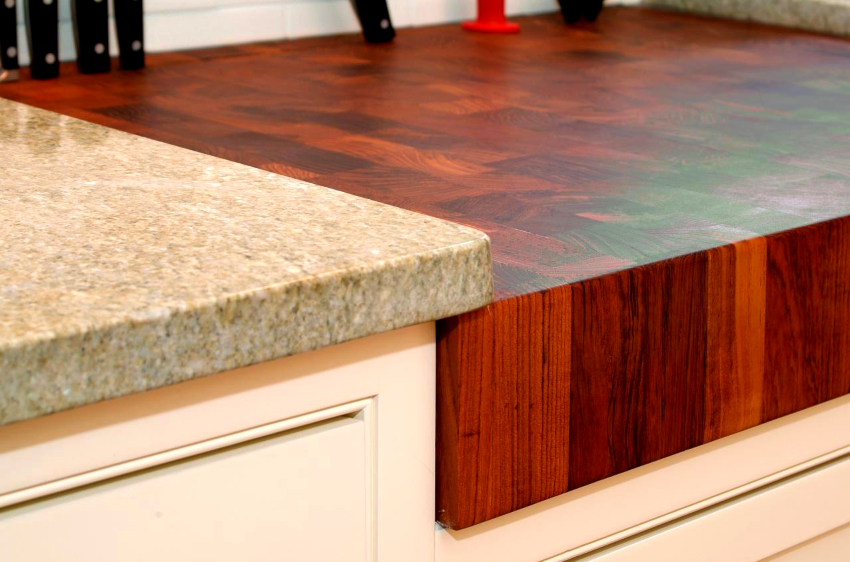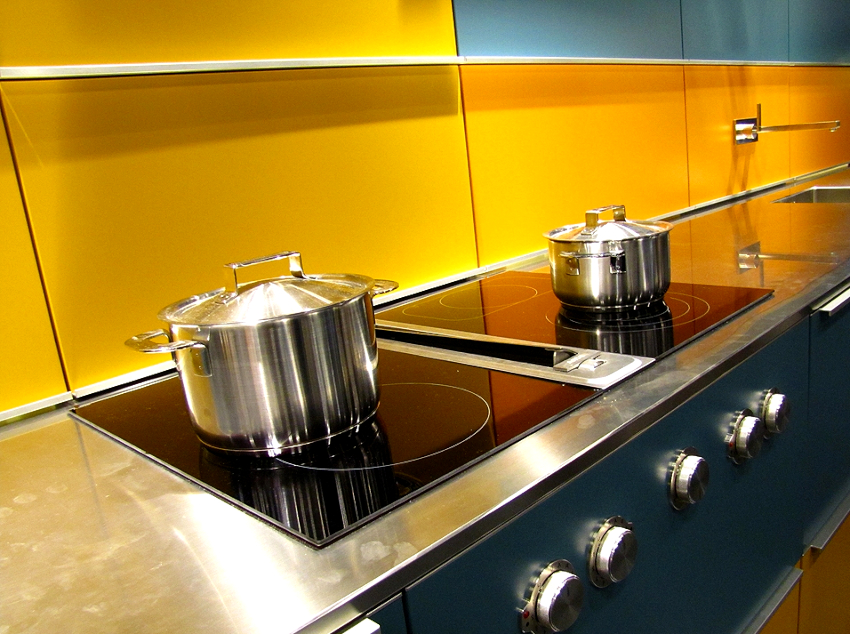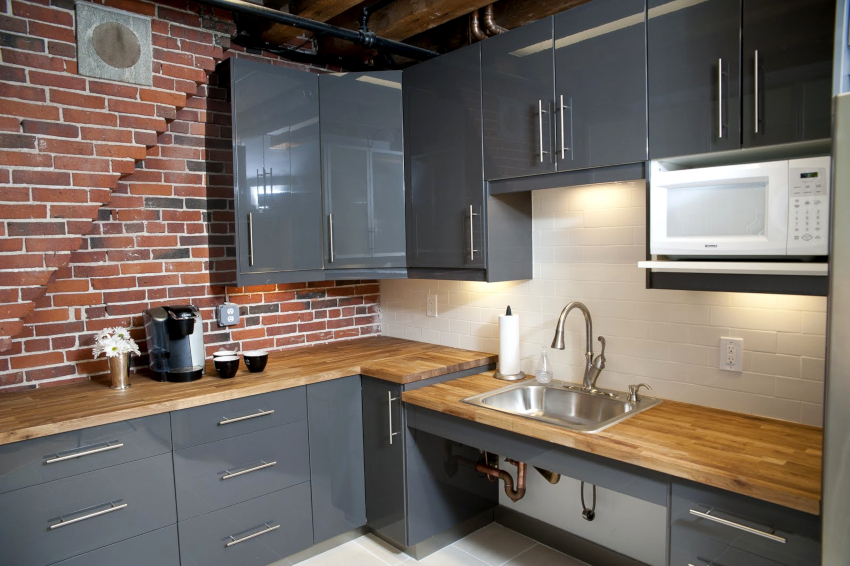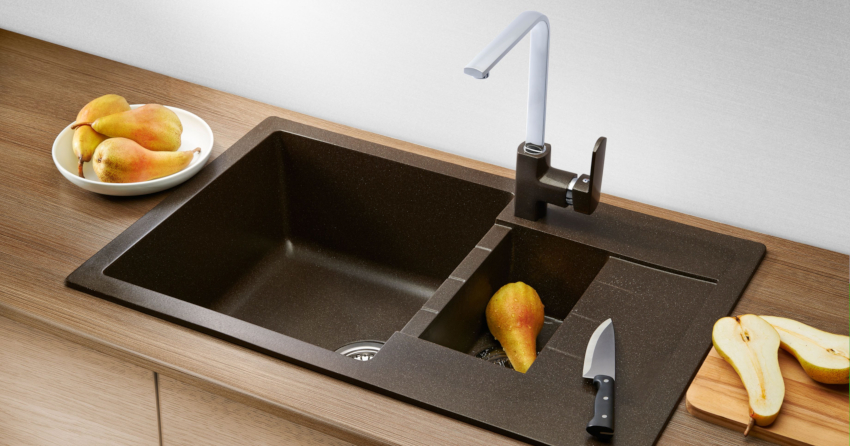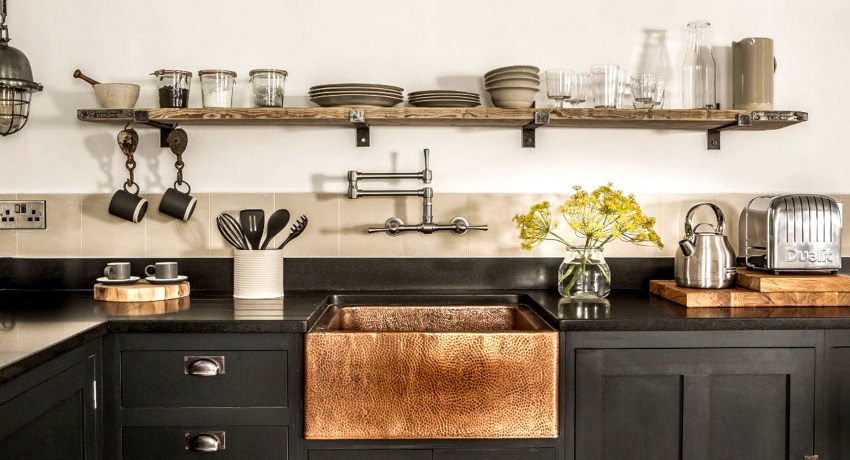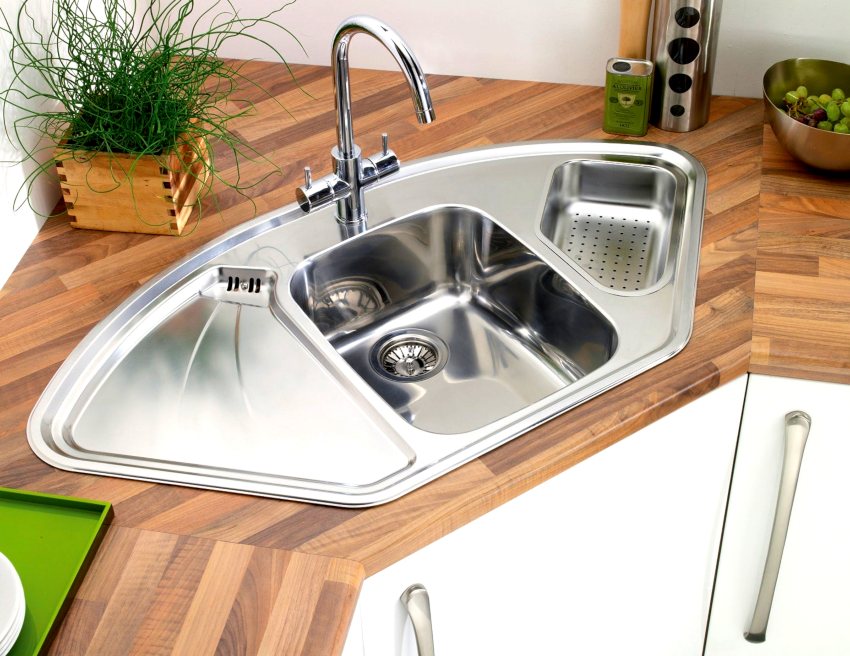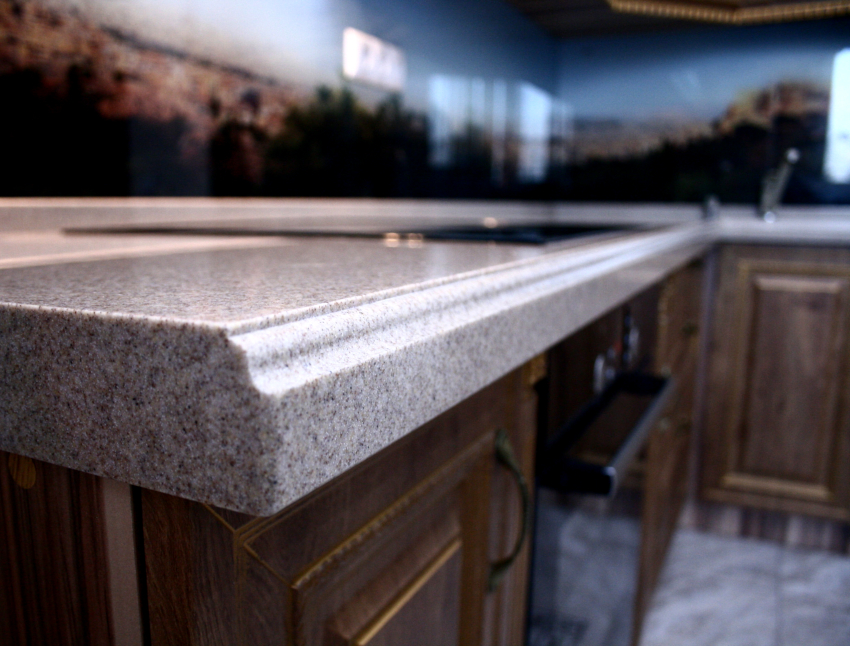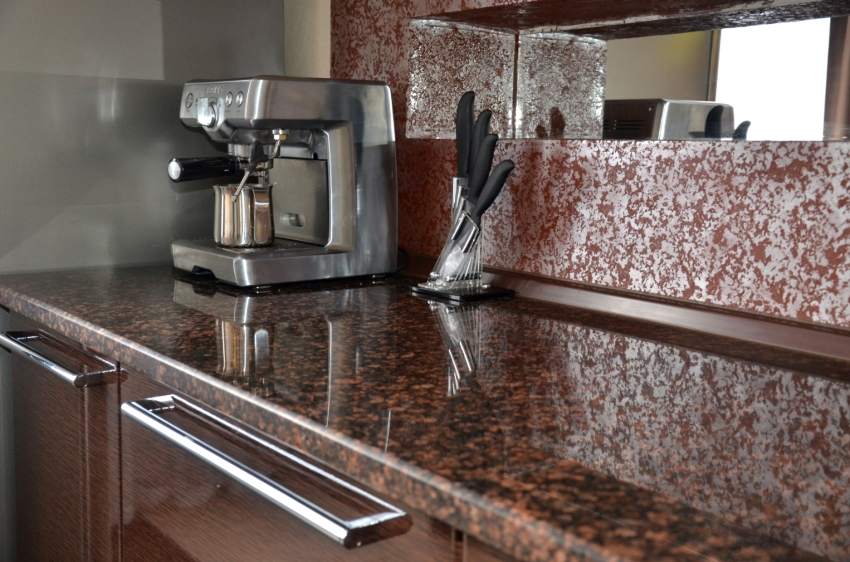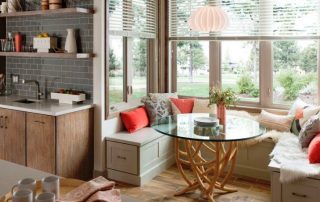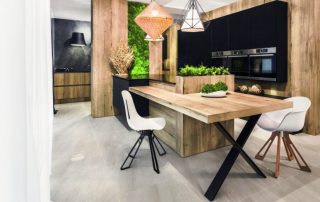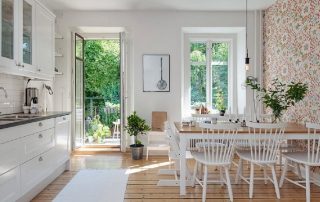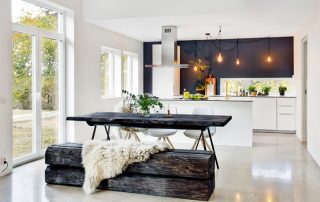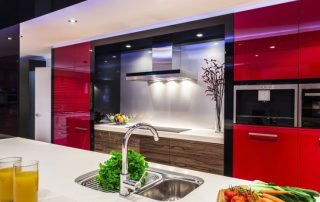Comfort is not a luxury, but a vital necessity. The modern rhythm requires a lot of energy from a person. The restoration of physical and emotional strength should be facilitated by the furnishings of each room in a residential building. Discomfort not only interferes with recovery, but also increases fatigue. So that using the kitchen is not annoying and cooking is enjoyable, you need to choose the right size for the kitchen countertop.
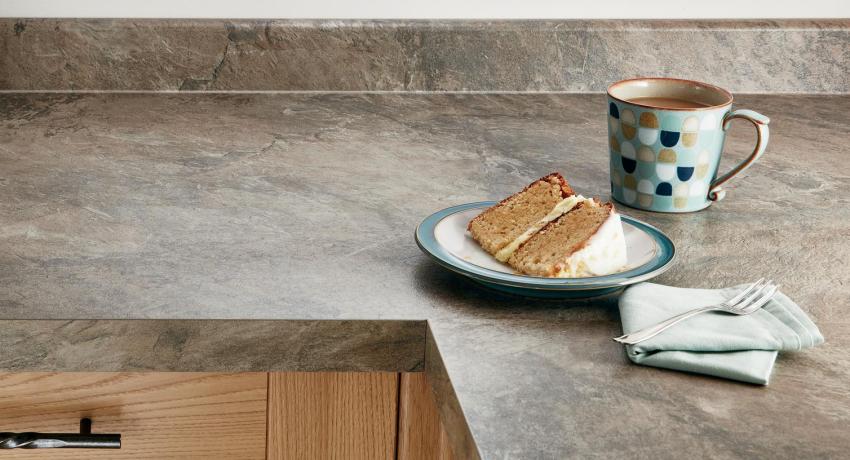
The size kitchen countertops is selected depending on the general parameters of the room and the dimensions of the furniture
Content
Countertops dimensions: deviation from typical and standard
The worktop is a very important and significant element of the kitchen. Being more often a simple shape - a regular rectangle (sometimes made up of fragments), it carries the maximum mechanical load in comparison with other kitchen surfaces. Its size is chosen depending on the general parameters of the room, the dimensions of other furniture. Installed permanently.
The main characteristics to consider when choosing a countertop are:
- sizes;
- material quality;
- surface color.
For a long time there was a standard for the size of kitchen countertops. It was due to the uniformity of the dimensions of the premises in multi-storey buildings. Even the kitchens in private houses were about the same size. The Cinderella headset was a versatile option. Then craftsmen began to appear, ready to customize the countertop. Today, the furniture industry produces a variety of options that differ in both dimensions and material.
The main characteristics of the dimensions of the countertops:
- length;
- width (depth);
- thickness.
Certain restrictions still exist today. For example, wood-based countertops have a length limit. Natural stone surfaces are most often made to order. The width of kitchen worktops remains the most standardized. This is due to the optimal size offered. Very narrow or wide surfaces are inconvenient to use.
Traditionally, the countertop is installed along the wall. In this regard, even the name "working wall" appeared. Modern designers offer other positions of countertops, their non-standard shapes, which can be made to order.
Kitchen countertop height: comfort and health
Most of the time in the kitchen, the hostess or other family member involved in cooking spends just behind the work surface. The height of the kitchen from floor to counter will affect the position of the body while cooking. The low-lying table top forces the spine to flex significantly. With a long stay in this position, it begins to bend, which negatively affects blood circulation. At an excessively high surface level, the load on the muscles of the arms increases, which leads to their rapid fatigue.
The main indicator when choosing the height of the working surface is growth. There is a scale that determines the correspondence of the height of a person's height and the size of the tabletop. However, it should be borne in mind that this is not information received from specialists, but the result of experience and observation.
| Man's height | Table top height |
| Up to 160 cm | 75-80 cm |
| 160-175 cm | 82-90 cm |
| 175 cm and above | 91-100 cm |
Due to the fact that the figure of each person is unique, the level of the hands may be different. Therefore, it is worthwhile to carry out the following additional calculations of the required height when selecting a kitchen countertop for the size of the body:
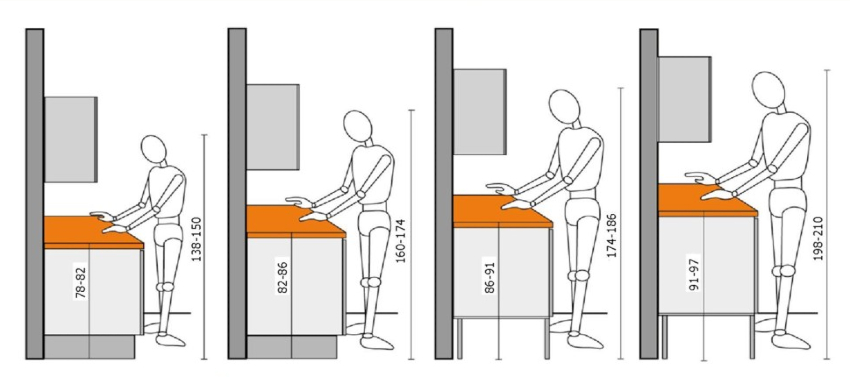
When determining the height of the working surface, one should not focus on the growth of all households.
- stand up with your back straight;
- bend your elbows at a right angle and fix a point 15 cm lower;
- measure the distance from the floor to the point - this will be the optimal height of the tabletop.
Useful advice! When determining the height of the working surface, you should not choose the option obtained by calculating the average height of all households. Such a tabletop will be inconvenient for everyone.
One of the ways to create comfortable conditions when using the work surface can be the presence of adjustable legs in the furniture design.
Does the height of the kitchen countertop affect the interior
The interior is an important component of the cosiness and comfort of the room. Not only design features, but also the size of the product is of no small importance in this case. The length of the kitchen countertop is determined by the availability of free space, and therefore it should be proportional to the dimensions of the room.
The required height is selected in a completely different way. Most often, problems arise when the ceiling height does not exceed 240 cm, and the work surface needs to be raised above the floor level by 95 cm and higher. In no case should the height of the product be reduced to suit the interior. It is necessary to use other solutions, for example, to install the structure on high legs. You can make a niche under the countertop, place the sink and the hob next to it, shifting it to one side. The light color of the surface and facade of the lower kitchen block will also contribute to a visual reduction in size.
Looking through the catalogs, paying attention to what sizes are kitchen countertops, it is easy to see that thickness affects the visual assessment of the size of this element to a large extent. It is worth dwelling on this indicator separately.
The thickness of the kitchen countertop: the dependence of the size on the material of manufacture
The thickness of the countertop is not just about visual perception. This is largely the strength, which is determined by:
- heat resistance;
- moisture resistance;
- resistance to mechanical stress;
- wear resistance.
Worktops made from different materials are characterized by different thicknesses.
Domestic chipboard working surfaces have a value of this indicator equal to 28 mm and 38 mm. Foreign companies offer wood products 60 mm thick.
Solid wood countertops are often 40 mm in size. When placing an individual order, many consumers prefer to increase this figure to 50-60 mm, and sometimes up to 80-100 mm.
Artificial stone countertops have upper and lower limits. If the thickness does not exceed 12 mm, such a stone cannot be used for the work surface, manufacturers do not guarantee quality. The use of artificial stone with a thickness of 12-15 mm requires a backing of plywood or other wood materials, which increases the size of the tabletop as a whole. The thickness of 40 mm is the maximum for a surface made directly from stone.
Sizes of natural stone kitchen countertops are less standardized. They are often performed according to individual orders, the dimensions of a solid plate for the working surface depend on the size of the slab (billet).
Glass countertops are quite popular. They are usually made of several layers and have a total thickness of 8-20 mm. Metal work surfaces consist of a base covered with medical steel, the thickness of which ranges from 0.8 to 1.2 mm.
For concrete surfaces, heavy weight, requiring a special base, and an aesthetic component can become the thickness limiter.
Useful advice! When buying or ordering kitchen furniture with a thick worktop, you should pay special attention to the quality of the supports. They must be made of a material that can withstand constant stress for a long time.
Tabletop width: standard and possible changes
The width (depth) of the kitchen countertop affects not only the area of the working surface, but also the dimensions of the lower furniture block. That is why this value is characterized by a certain constancy: the standard for the width of the kitchen countertop is 60 cm.
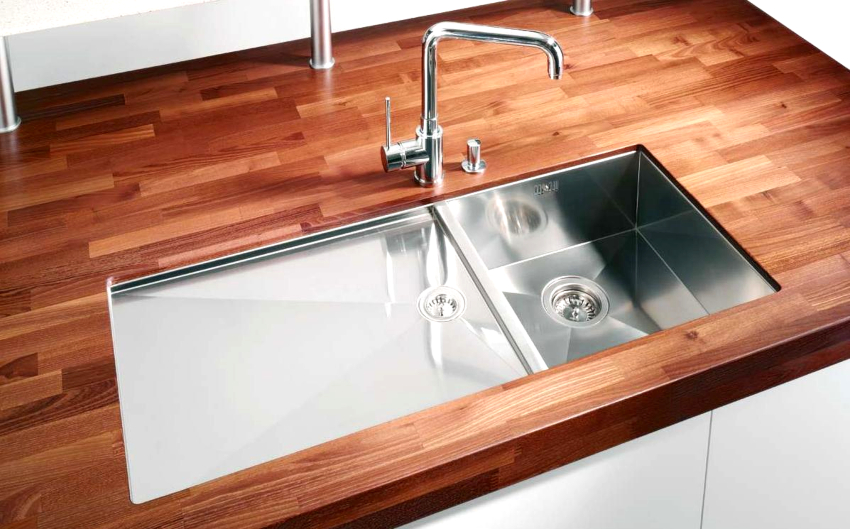
The width of the kitchen countertop affects not only the area of the working surface, but also the dimensions of the lower furniture block
This depth allows you to place drawers and shelves of convenient sizes at the bottom of the kitchen unit. Traditionally, 100-120 mm of the countertop is allocated to create a sanitary zone (free space between the wall and furniture), 50-80 mm is a rounded overhanging edge that protects against liquids from draining from the working surface to the front parts of the lower module. Depth of drawers and shelves with a standard table top is 400-420 mm. This size provides good storage capacity and convenient handling.
Reducing the width of the kitchen countertop leads to a significant limitation of operational capabilities. Household appliances should be removed immediately after use to make room for other activities. You cannot arrange and decompose the required number of objects at the same time. The doors of the wall cabinets are close, you need to move away to open them, etc.
Many housewives of large kitchen areas prefer to increase the width of the countertop. Having made such a decision, it is required to take into account the following disadvantages:
- objects standing at the inner edge of the countertop are difficult to reach - inconvenient grip;
- it is necessary to reach out to electrical outlets to turn on household appliances;
- excessive remoteness of wall cabinets;
- wall cabinets made in accordance with the increased dimensions look cumbersome, it is problematic to remove items from the upper shelves.
Useful advice! With the increased dimensions of the table top (900-1000 mm), it is better to equip the lower part of the furniture with drawers, and not shelves, the use of which at such a depth will be extremely inconvenient.
Making the most of space: corner kitchen countertop
One of the most common countertops options is corner ones. This type is especially convenient for square-shaped rooms. After installation, there remains an area where you can place a dining table, to which there will be a free approach from all sides.
The dimensions of the corner countertop for the kitchen are selected according to the same principle as for the traditional rectangular version: comfortable height, convenient width, thickness depending on material, design, and performance characteristics.
Important! The extreme corner zone of this shape of the countertop will be significantly removed at a depth exceeding the standard dimensions.
Depending on the configuration and integrity, the following types of tabletops are distinguished:
- Monolithic. They are a solid slab without seams or joints. Quite a difficult option to install, but the performance is high. Such surfaces, especially those with a non-porous structure, do not allow moisture to pass through - the main source of aging and deterioration of this kitchen element.
- L-shaped. These kitchen countertops allow you to make the most of your space. More often this is a composite option, where the short part may have a shallower depth.
- Surfaces composed of three elements. The two rectangular pieces are complemented by a separate corner piece. This design is appropriate when an oven or a large sink is installed in the corner zone. This configuration also presupposes a separate corner facade, which becomes an interesting element of the interior.
Corner countertops have no restrictions on materials of manufacture. They can be made of both wood materials and artificial or natural stone, concrete.
Related article:
Corner sink for the kitchen: the best option for a small room
Varieties of shells. Installation methods. The shape and dimensions of the corner models of sinks. Choice of corner sink cabinet.
Corner countertops in the interior of a small kitchen
Corner countertops certainly increase the area of the work surface, but they are also significant in size. Is it possible to install this option in a small kitchen? Quite, but on condition that the layout of the premises allows. And the shape of the countertop itself should be chosen optimal.
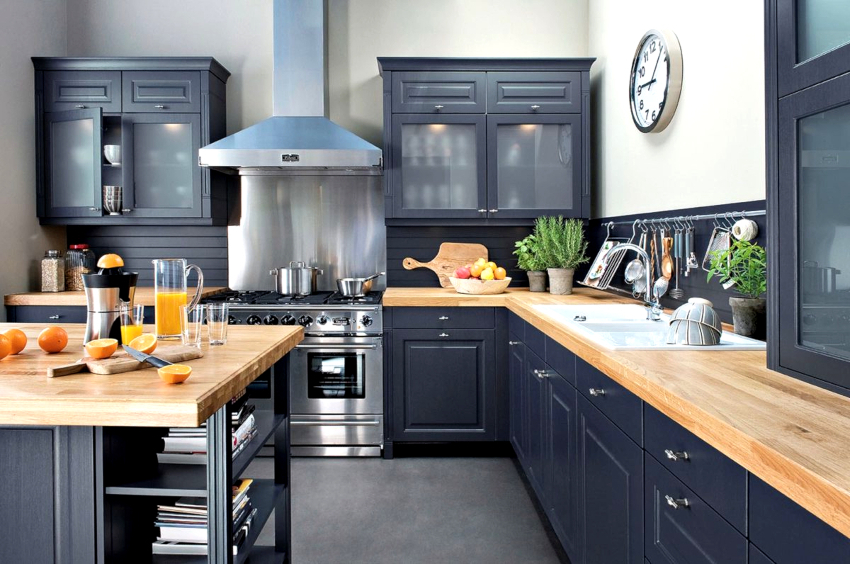
A corner countertop for a small kitchen can be chosen both light and dark, but it is better if it does not contrast with the facades
In no case should the width of the countertop be reduced. Standard sizes for a small kitchen are quite acceptable. Rounded end parts will help to visually free up space. In addition, they will facilitate free movement. A corner countertop for a small kitchen can be chosen either light or dark, but it is better if it does not contrast with the facades.
Skirting boards can play an important role in interior design. For kitchen countertops that are 10-12 m², it is recommended to choose an option that does not stand out against the background of the wall. Such an accessory will not outline the border, will not create the feeling of a frame, it will simply fulfill its functional purpose - to prevent moisture and food particles from entering the unwanted area.
It is not necessary to equip a separate wide facade for the corner area in a small kitchen. This is not only visually, but in fact will take up significant space. A kitchen set with such a countertop is more suitable for large and high rooms.
Useful advice! If the kitchen area is less than 9 m², it is better to place one of the sides of the corner tabletop along the wall with a window. The absence of wall cabinets and good natural light will help create the feeling of a lot of free space.
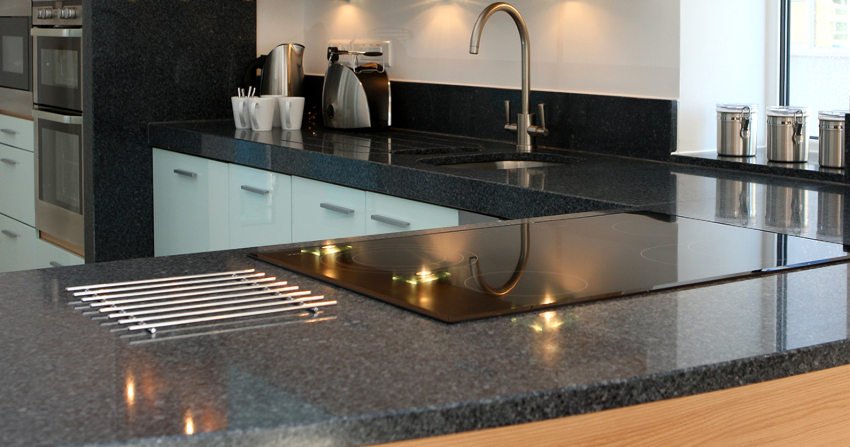
If the kitchen area is less than 9 m², it is better to place one of the sides of the corner countertop along the wall with a window
Kitchen countertops made of chipboard and other wood materials
The most common material for kitchen worktops is waste from the wood industry. Chipboards are made from sawdust mixed with resins by hot pressing. MDF (fine fraction) is a fibreboard made from fine sawdust, which is first dried and then glued together. Both materials have an outer coating - lamination.
MDF and chipboard countertops share the following common features:
- the material has an affordable price;
- relatively light weight, does not require significant physical effort during installation;
- easy to process;
- heat resistant;
- shockproof;
- available in a wide variety of exterior colors.
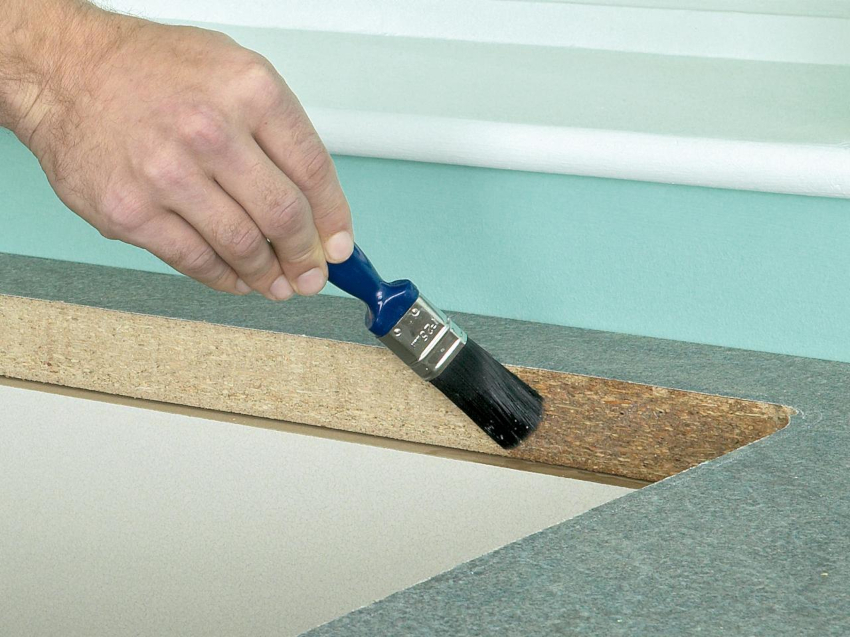
When joining parts of a tabletop made of wood materials, cutting the cuts and using a sealant are mandatory
Assessing the disadvantages, we can highlight the following:
- low degree of environmental friendliness;
- exposure to moisture.
If we compare the qualities of these two materials, it should be noted that chipboard is cheaper, emits formaldehydes, and is more susceptible to moisture. The MDF countertop for the kitchen will be more moisture resistant, but it will also cost more. Both materials require hermetically sealed ends. Chipboard is covered with a protective layer on both sides, MDF - only on the outside.
The dimensions of the kitchen countertops made of chipboard and MDF are standard: 28-60 mm - thickness and 3.5 m - maximum length. From these materials, you can cut out a work surface of any configuration, using a solid sheet as a blank.
Useful advice! When joining parts of a tabletop made of wood materials, it is worth paying special attention to sealing the joints. Cutting and using a sealant are mandatory.
Plywood is also used for the manufacture of countertops. This material is often used as a base on which slabs of stone or concrete screed are laid.
Euro-sawed countertops: perfect quality under certain conditions
Eurozapil is most often used when installing corner forms, as well as for standard tabletops. In fact, this is a docking-lock: one part has a sample of a certain shape and size, and the second is a protrusion that must fit into it. Such a connection is durable, leaving no traces of a seam, which is practically invisible with a high-quality Euro saw.
Selections are made on high-precision milling machines using patterns. You should not try to make such a cut with a conventional sawing device. Even the smallest chips will certainly appear when joining.
Not only the aesthetic side is a positive aspect of this connection. Eurozapil provides high tightness, which is especially important for the good functioning and durability of the surface. The two connection areas have no gaps or cavities, they fit tightly to each other.
Along its entire length, the worktop can be used for a variety of purposes without fear of moisture seeping into the seams. Despite the perfection, the sections are treated with means that enhance the tightness before joining.
In the presence of significant positive characteristics, eurozapil also has a drawback, which is expressed in strict requirements both for the lower furniture block and for the room as a whole. The tabletop connected by the eurosaw method must be installed on a perfectly flat surface, otherwise the seam will simply begin to diverge during use.Consequently, the floor plane should not have any flaws.
The depth of the countertop with this method of connection does not matter, but if the walls are uneven, a gap may form, which is sometimes quite difficult to close without losing aesthetics.
Stone countertops for the kitchen: a combination of presentability and strength
Stone countertops are a real decoration of the kitchen. The appearance of this type of work surfaces was originally due to the desire for naturalness, naturalness. Presentable appearance and good performance distinguish this material. Countertops can be made of both artificial and natural stone. Of the artificial options, acrylic stone and quartz agglomerate are most often used.
Acrylic stone has the following components:
- acrylic polymer;
- aluminum trihydrate;
- dyes.
Quartz agglomerate consists of quartz chips and a synthetic binder. Both materials are durable, heat and moisture resistant.
The thickness of the countertop made of artificial stone (of both types) is not less than 12 mm, the maximum is 30-40 mm.
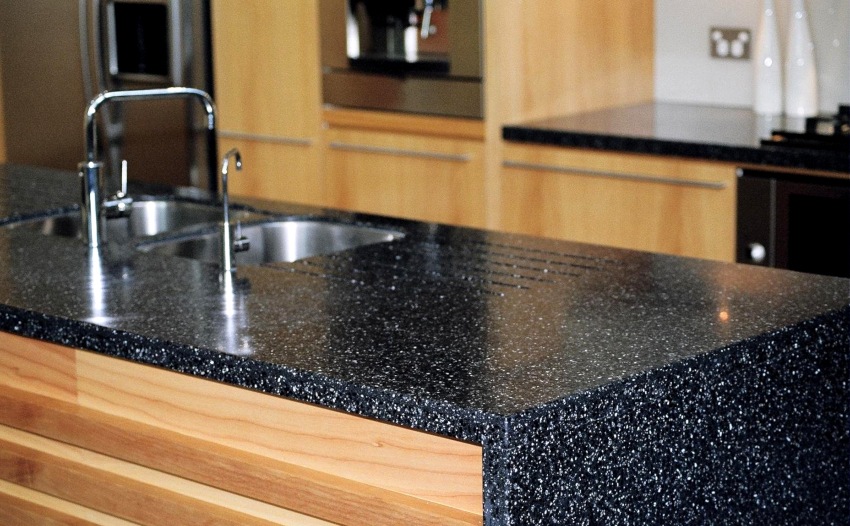
The most common materials for the manufacture of countertops from natural stone are granite and marble.
Acrylic countertops can be joined with virtually no seams, so they have no size restrictions. Quartz surfaces are increased by gluing parts together. Only a specialist with a high level of professionalism can make the connection as invisible as possible.
The most common materials for making countertops from natural stone are granite and marble. In addition to strength, aesthetics, these surfaces have another indisputable advantage: the appearance can be restored by grinding.
Natural stone surfaces are characterized by standard countertop depths. For kitchens large or small, custom-made versions with deviations from the standards can be made. A thickness of 30 mm is considered optimal in terms of accessibility of installation and cutting holes for a sink and a hob.
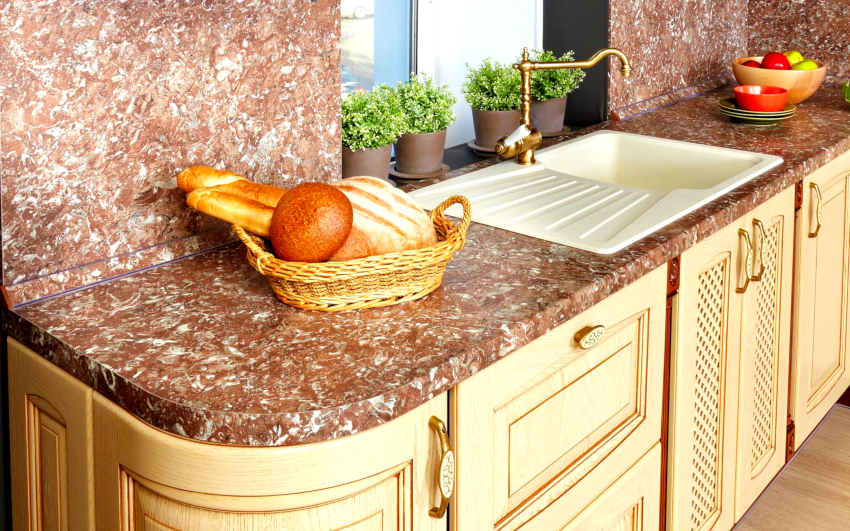
When buying or ordering natural stone countertops, you need to pay attention to the quality of the edge
Useful advice! When buying or ordering natural stone countertops, you need to pay attention to the quality of the edge. It significantly affects both the comfort of use and the aesthetic appearance.
Kitchen countertop dimensions: changing doesn't mean improving
The existing standard sizes of kitchen countertops cannot be considered random, contrived or dependent only on the forms of manufacture of the material used. They are the result of observation, study and experience. Before increasing or decreasing traditional dimensional indicators, you need to make sure that the following actions are appropriate:
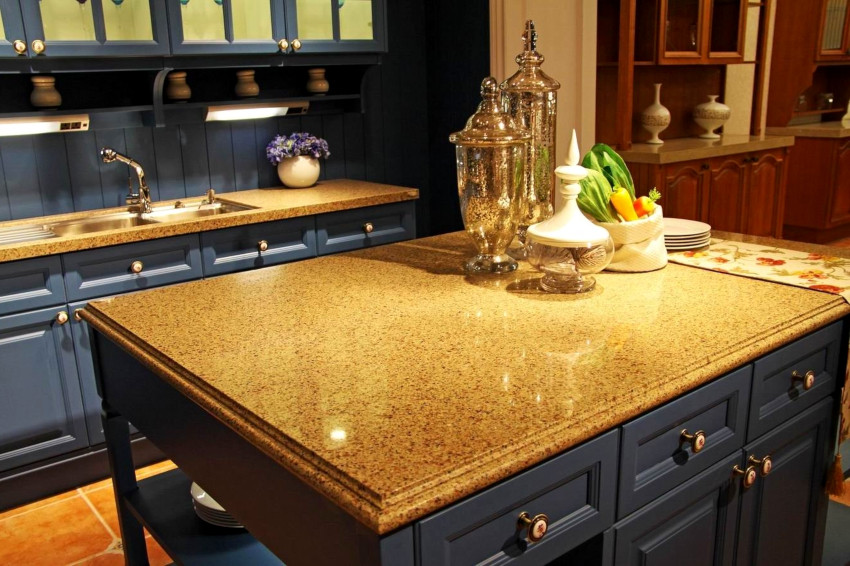
Before increasing or decreasing the traditional dimensions of the countertop, you need to make sure that such actions are appropriate.
- The increased depth of the countertop in the presence of free space can lead to the appearance of a dead zone, where various items will simply be stored as unnecessary.
- Before giving preference to the corner version of the countertop in order to increase the working surface, it is worth excluding the appearance of the feeling of “kitchen for the sake of beautiful furniture”. There should be enough space in the room for setting up a dining table and comfortable placement behind it.
- The large thickness of the countertop should be in harmony with the rest of the kitchen furniture.
- The lower unit of the kitchen set installed on the podium can make it inconvenient to use the work surface.
The worktop is one of the main elements of the kitchen space. It should define the shape and size of the rest of the furniture. Even the most expensive and durable work surface made of natural stone will not add positive to the cooking process if it has size-related disadvantages that affect the operating conditions.
